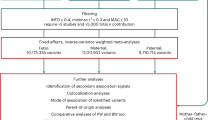Summary
With a view to the obvious increase in mean birth weight and the birth of children over 4000 G in the last two decades a study was made on the relationship between infant weight, placental weight and maternal weight and height by means of partial correlation.
-
1.
A relationship between infant weight and placental weight is significant with a correlation coefficient of +0.53. This remains almost unchanged when the other variables under examination are kept constant and therefore eliminated.
-
2.
The correlation between maternal weight and placental weight has also been established as statistically significant and remains so under the condition of constant infant weight.
-
3.
A direct relationship between maternal factors such as constitution and nutrition, (as demonstrated in height and weight) and infant birth weight only seems to exist with respect to the maternal weight—correlation coefficient +0.164. This positive correlation almost disappears however when the placental weight is kept constant. These findings suggest that there is no direct relationship between maternal and infant weight, but only indirectly through the placenta.
Zusammenfassung
Im Hinblick auf die in den letzten beiden Jahrzehnten zu beobachtende Zunahme der Durchschnittsgeburtsgewichte und der Geburten schwerer Kinder über 4000 g wurden die Zusammenhänge zwischen Kindesgewicht, Placentagewicht sowie Muttergewicht und -große mittels partieller Korrelationen untersucht.
-
1.
Ein Zusammenhang zwischen Kindesgewicht und Placentagewicht ist mit einem Korrelationskoeffizient +0,53 gesichert und bleibt auch unter Konstanthaltung und damit Elimination aller übrigen untersuchten Variablen nahezu unverändert.
-
2.
Ein Zusammenhang zwischen Muttergewicht und Placentagewicht ist ebenso gesichert und bleibt auch weiterhin unter Konstanthaltung des Kindesgewichtes bestehen.
-
3.
Ein direkter Zusammenhang mütterlicher Faktoren wie Konstitution und Ernährung, repräsentiert durch Größe und Gewicht, zum Neugeborenengewicht scheint nur hinsichtlich des Muttergewichtes mit einem Korrelationskoeffizienten von +0,164 gesichert zu sein. Diese positive Korrelation verschwindet jedoch praktisch unter Konstanthaltung des Placentagewichtes.
Aus diesen Ergebnissen läßt sich folgern, daß eine direkte Beziehung des Muttergewichtes zum Kindesgewicht nicht besteht, sondern nur indirekt auf dem Wege über die Placenta zustande kommen dürfte.
Similar content being viewed by others
Literatur
Aberle, S. B. D., Morse, A. H., Thompson, W. R., Pitney, E. H.: The relation of the weight of the placenta, cord and membranes to the weight of the infant in normal full-term and in premature deliveries. Amer. J. Obstet. Gynec.20, 397 (1930)
Adair, F. L., Thelander, H.: A study of the weight and dimensions of the human placenta in its relation to the weight of the newborn infant. Amer. J. Obstet. Gynec.10, 172 (1925)
Anderson, T. W.: An introduction to multivariate statistical analysis. New York: John Wiley 1958
Aravantinos, D., Lolis, D.: Schwangerschaft und Praediabetes. Geburtsh. u. Frauenheilk.26, 544 (1966)
Auinger, W.: Zum Effekt prophylaktischer Maßnahmen bei auf Praediabetes suspekten Schwangeren. Wien. klin. Wschr.82, 889 (1970)
Auinger, W.: Zur Häufigkeit des latenten Diabetes in Schwangerschaft u. Wochenbett (im Druck)
Bach, H. G., Konrad, U.: Die Geburt von Riesenkindern (>5000 g). Geburtsh. u. Frauenheilk.21, 929 (1961)
Brehm, R., Janisch, H.: Latenter Diabetes, Schwangerschaft und schwere Kinder. Wien. klin. Wschr.80, 113 (1968)
Calkins, L. A.: Placental variation, an analytical determination of its clinical importance. Amer. J. Obstet. Gynec.33, 280 (1937)
Giese, R., Kaiser, K.: Die Beeinflussung des Geburtsgewichtes durch schlechte Ernährungsverhältnisse während des Krieges und der Nachkriegsjahre 1938–1946. Zbl. Gynäk.69, 583 (1947)
Guggisberg, H., Neuweiler, W.: In Seitz-Amreich, Biologie und Pathologie des Weibes, Bd. II: Konstitutionsstörungen und Wachstumsstörungen. 1957
Herold, K.: Riesenkinder und Zuckerbelastung. Geburtsh. u. Frauenheilk.27, 256 (1967)
Hohlbein, R., Hödl, H.: Wie oft sind Riesenkinder die Folge einer Diabeteserkrankung der Mutter? Zbl. Gynäk.78, 1103 (1956)
Horky, Z., Jutzi, E.: Das Plazentagewicht bei Diabetes mellitus. Zbl. Gynäk.86, 769 (1964)
Hosemann, H.: Ernährung und fetale Entwicklung. Dtsch. med. Wschr.72, 507 (1947)
Hosemann, H.: Schwangerschaftsdauer und Neugeborenengewicht. Arch. Gynäk.176, 109 (1949)
Hosemann, H.: Schwangerschaftsdauer und Gewicht der Placenta. Arch. Gynäk.176, 453 (1949)
Kirchhoff, H.: Die Akzeleration des Neugeborenen. Geburtsh. u. Frauenheilk.27, 565 (1967)
Knaus, H. H.: Das Gewicht der Placenta und seine forensische Bedeutung. Zur Einheit von Foetus und Plazenta. Zbl. Gynäk.85, 177 (1963)
Lawley, D. N., Maxwell, A. E.: Factor analysis a statistical method. London: Butterworth 1963
Linder, A.: Statistische Methoden für Naturwissenschaftler Mediziner und Ingenieure, 3. Aufl. Basel u. Stuttgart: Birkhäuser 1960
Lund, C. J., Weese, W.: Glukose tolerance and excessively large babies in nondiabetic mothers. Amer. J. Obstet. Gynäk.65, 815 (1953)
Milz, K.: Über das Gewicht der Plazenta und seine Beziehung zu Schwangerschaft und Geburt. Med. Diss. Göttingen 1946
Oehlert, G., Weiland, A.: Mütterlicher Praediabetes und Neugeborenengewicht. Zbl. Gynäk.41, 1460 (1964)
Ohlenroth, G.: Über die geburtshilfliche Bedeutung des foetalen Riesenwuchses und den Einfluß der mütterlichen Ernährung auf das Neugeborénengewicht. Zbl. Gynäk.86, 228 (1964)
Pokorny, J.: Über sehr große Kinder in der Geburtshilfe. Zbl. Gynäk.83, 880 (1961)
Schubert, G.: Riesenwuchs beim Neugeborenen. Mschr. Geburtsh. Gynäk.23, 453 (1906)
Solth, K.: Das Wachstum der Plazenta im Zusammenhang mit Kindesgewicht und Tragzeitlänge. Zbl. Gynäk.83, 1558 (1961)
Tenhaeff, D.: Diabetes und Akzeleration beim großen Neugeborenen. Geburtsh. u. Frauenheilk.28, 737 (1968)
Westermark, H.: On the weight of the human placenta relative to that to the foetus under various circumstances. Acta obstet. gynec. scand.4, 249 (1926)
Zangemeister, W.: Studien über die Schwangerschaftsdauer und die Fruchtentwicklung. Arch. Gynäk.107, 405 (1917)
Zangemeister, W., Lehn, Ch.: Geburtshilfliche Bedeutung übergroßer Fruchtentwicklung. Arch. Gynäk.109, 500 (1918)
Zschiesche, W., Gerlach, H.: Biometrische Untersuchungen über die Plazenta und die Beziehungen zwischen Plazenta und Frucht. Arch. Gynäk.199, 199 (1963)
Author information
Authors and Affiliations
Rights and permissions
About this article
Cite this article
Auinger, W., Bauer, P. Zum Zusammenhang zwischen Kindesgewicht, Placentagewicht, Muttergewicht und Muttergröße. Arch. Gynak. 217, 69–83 (1974). https://doi.org/10.1007/BF00666640
Received:
Issue Date:
DOI: https://doi.org/10.1007/BF00666640




